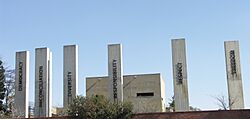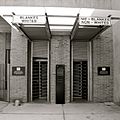Apartheid Museum facts for kids

Pillars of the Constitution
|
|
| Established | November 2001 |
|---|---|
| Location | Johannesburg, South Africa |
| Type | Specialised museum on Apartheid |
The Apartheid Museum is a special place in Johannesburg, South Africa. It teaches visitors about a difficult time in South African history called apartheid. This museum opened in November 2001.
Apartheid was a system of unfair rules. These rules separated people based on their race. The museum helps us understand this period. It also shows how South Africa moved towards a fair and equal society. Several times a year, the museum holds events. These events celebrate the end of apartheid. They also celebrate the start of a multiracial democracy for everyone in South Africa.
Contents
Exploring the Apartheid Museum
The Apartheid Museum has many interesting exhibits. They help tell the story of South Africa's past. Each exhibit teaches something important.
The Pillars of South Africa's Values
When you first arrive, you will see the Pillars of the Constitution. These are tall pillars in the museum's courtyard. Each pillar stands for an important value. These values are part of the South African Constitution. They include Democracy, Equality, Reconciliation, Diversity, Responsibility, Respect, and Freedom. They show what South Africa believes in today.
Understanding Race Classification
The museum's entrance itself is part of an exhibit. It is called Race Classification. During apartheid, people were divided into different groups. These groups were based on their race. People were called "native" (Black), "white", "coloured", or "Asian".
When you enter the museum, you get a ticket. This ticket randomly assigns you to one of two entrances. One entrance was for "white" people. The other was for "non-white" people. This helps visitors feel a small part of what it was like. Inside, you can see old identity documents. These documents showed a person's race. The items you see first depend on which entrance you used.
Journeys: People of Johannesburg
Outside the main museum building, you will find the Journeys exhibit. This area has large photos of people. These are descendants of individuals who came to Johannesburg. They arrived after gold was discovered in 1886. Many different races of people came to the city.
Apartheid tried to keep people of different races apart. In this exhibit, you walk past the backs of the people in the photos. It feels like they are walking with you. If you turn around after passing a photo, you can see the person's face. This exhibit shows the diverse history of Johannesburg.
The Segregation Policy
The Segregation exhibit explains an older policy. This policy was called segregation. It became official in the Union of South Africa in 1910. Segregation also separated people by race. Under this policy, Black people and white women were not allowed to vote. Segregation set the stage for the later system of apartheid.
Images for kids
-
The racially-segregated entrance to the museum








